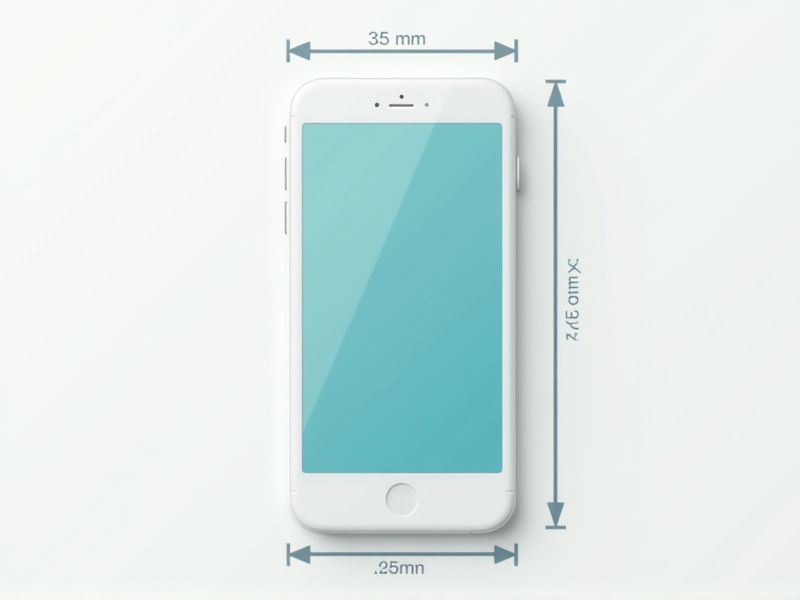
When considering the standard dimensions of phone screens, most modern smartphones range from 5.5 inches to 6.7 inches measured diagonally. For example, a typical phone screen might measure 6.1 inches diagonally, with an aspect ratio of 19.5:9, resulting in an actual display size of about 146 mm by 68 mm. These measurements offer users a balanced experience--providing enough screen space for comfortable reading and video viewing while remaining easy to hold in one hand. Keep in mind that manufacturers may vary slightly, but these dimensions are common for today's smartphones and can help in choosing the right device or designing mobile-friendly content.
Aspect Ratio
The standard phone screen aspect ratio has evolved, with 16:9 being the most common configuration in many devices. However, recent trends have shifted towards taller ratios, such as 18:9 or 19.5:9, enhancing the viewing experience for multimedia content. This change allows for a more immersive display, making it easier to consume videos and play games without compromising the screen size. If you're considering a new phone, be alert to how these ratios affect your daily usage and comfort.
Pixel Density
A smartphone screen's pixel density, measured in pixels per inch (PPI), significantly influences image clarity and detail. For instance, a display with 400 PPI or higher typically delivers sharp visuals, making text and images appear crisp and lifelike. Many high-end smartphones, such as the Google Pixel series, feature pixel densities exceeding 400 PPI, which enhances your viewing experience, especially when streaming videos or playing games. With the average smartphone pixel density around 300 PPI, understanding this metric can help you make an informed choice when purchasing your next device.
Screen Resolution
A standard phone screen typically boasts a resolution of at least 1080 x 2400 pixels, commonly referred to as Full HD+. This high pixel density enhances your viewing experience, providing sharp images and vibrant colors, with over 400 pixels per inch (PPI) in many models. Premium smartphones may elevate this further, with resolutions reaching QHD (1440 x 2960) or even 4K (2160 x 3840) for remarkable clarity and detail. Optimal screen resolution plays a crucial role in everyday tasks, such as video streaming, gaming, and photo editing, allowing you to appreciate every detail with precision.
Diagonal Size
The standard diagonal size of smartphone screens has progressively increased, with the average display measuring around 6.5 inches in 2023. This growth enhances your viewing experience, allowing for sharper images and more immersive interactions. Larger screens often feature higher resolutions, such as Full HD or 4K, providing clearer visuals with pixel densities exceeding 400 pixels per inch. Ensuring that your device aligns with these evolving standards can significantly improve your media consumption and app usability.
Bezel Thickness
The standard bezel thickness for modern smartphones typically ranges from 1 mm to 5 mm, significantly influencing the device's overall aesthetics and screen-to-body ratio. A thinner bezel, often found in flagship models, can improve immersion by maximizing display area while maintaining a compact form factor. For example, brands like Samsung and Apple have achieved bezel sizes as thin as 2 mm, enhancing user experience during media consumption. Your phone's bezel thickness can affect not just its look but also how comfortable it feels in your hand, balancing style with functionality.
Screen-To-Body Ratio
The screen-to-body ratio is a critical metric in modern smartphone design, reflecting the proportion of the display area to the entire front surface of the phone. Premium devices typically boast screen-to-body ratios exceeding 90%, providing users with a more immersive viewing experience by minimizing bezels. For instance, flagship models from leading manufacturers often achieve ratios of 91% to 95%, enhancing not only aesthetics but also usability. When choosing a smartphone, consider how the screen-to-body ratio influences your interaction with content, as a higher value generally signifies a more engaging visual experience.
Display Type
The display type of a phone screen significantly influences your user experience, with the two predominant technologies being AMOLED and LCD. AMOLED (Active Matrix Organic Light Emitting Diode) screens provide vibrant colors and deeper blacks due to their ability to light individual pixels, while LCD (Liquid Crystal Display) screens typically offer better visibility in bright sunlight and consume less power when displaying static images. Most smartphones feature resolutions of at least 1080 x 2400 pixels, ensuring sharp images and detailed graphics for media consumption or gaming. When selecting a phone, consider that a higher refresh rate, such as 90Hz or 120Hz, enhances the fluidity of animations and scrolling, making your interaction smoother.
Touch Sensitivity
Touch sensitivity refers to the responsiveness of a phone screen to user inputs, measured in milliseconds (ms) for optimal performance. A standard touch screen typically has a response time of around 20-30 ms, ensuring fluid interaction when swiping or tapping. High-end devices may feature advanced capacitive technology, enhancing touch sensitivity to as low as 10 ms, which contributes to a more seamless user experience. When choosing a smartphone, consider the touch sensitivity alongside other specifications, as it significantly affects overall usability and engagement.
Refresh Rate
The refresh rate of a phone screen, measured in hertz (Hz), significantly impacts your viewing experience, especially in gaming and video playback. Modern smartphones typically feature refresh rates ranging from 60 Hz to 120 Hz, with high-end models reaching up to 144 Hz or even 165 Hz. A higher refresh rate provides smoother motion and reduced motion blur, allowing for fluid scrolling and enhanced responsiveness. When choosing a device, consider how the refresh rate affects your daily usage, as it can enhance both visual comfort and performance in interactive applications.
Color Accuracy
Color accuracy in phone screens typically measures how closely the displayed colors match standard reference colors. High-quality displays often achieve a color accuracy rating of over 95% sRGB coverage, ensuring vibrant and true-to-life visuals. Advanced technologies, such as OLED and AMOLED, enhance color depth and contrast, resulting in more immersive viewing experiences. For optimal performance, consider devices that support hardware calibration for maintaining color consistency across various lighting conditions.
